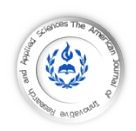



GENERAL INFORMATION

American Journal of Innovative Research & Applied Sciences
Share us on Social Media Links:



| ISSN: 2429-5396 (e) | www.american-jiras.com | All Rights Reserved |
| Web Site Form: v 0.1.05 | JF 22 Cours, Wellington le Clairval, Lillebonne | France |
| Web Site Form: v 0.1.05 | JF 22 Cours, Wellington le Clairval, Lillebonne | France |


ResearchBib, Google Scholar, SIS database, i.f.s.i.j, Scribd, IISJ, Eurasian Scientific Journal Index (ESJI), Indianscience.in, arastirmax, Directory of Research Journals Indexing, Pak Academic Sesearch, AcademicKeays, CiteSeerX, UDL Library, CAS Abstracts, J-Gate, WorldCat, Scirus, IET Inspec Direct, and getCited
Indexed by:
| HOME || ABOUT US || ARCHIVES || AIMS AND SCOP || AUTHORS || REVIEW|| SUBMIT MANUSCRIPT || EDITORIAL BOARD || CONTACT US |
| HOME | ABOUT US | ARCHIVE | AIMS AND SCOP | AUTHORS | REVIEW | SUMIBMIT MANUSCRIPT | EDITORIAL BOARED | PUBLICATION FEE |
| | ARTICLES | Am. J. innov. res. appl. sci. Volume 4, Issue 1, Pages 37-43 (January 2017) |
American Journal of innovative
Research & Applied Sciences
Research & Applied Sciences
ISSN 2429-5396 (Online)
OCLC Number: 920041286
OCLC Number: 920041286

|
| January | VOLUME 4 | N° 1 | 2017 |
Research Article
ANALYSE DES ELEMENTS MINERAUX ET EN TRACE DANS LA FEUILLE DE DESMODIUM CANUM, ERYTHROXYLUM SP, URENA LOBATA, ACRIDOCARPUS EXCELSUS PAR LA METHODE D’ANALYSE PAR FLUORESCENCE-X A REFLEXION TOTALE ANALYSIS OF MINERAL ELEMENTS, BY FLUORESCENCE X AT TOTAL REFLECTION, IN EUPHORBIA HETEROPHYLLA (PAKABE) OF ANTALAHA
ANALYSIS OF MINERAL ELEMENTS AND TRACE IN THE DESMODIUM SHEET CANUM, ERYTHROXYLUM SP, URENA LOBATA, ACRIDOCARPUS EXCELSUS BY THE METHOD OF TOTAL FLUORESCENCE ANALYSIS
| Harvel Randriamihevitra 1* | Lucienne V. Rakotozafy Randriamanivo 2 | and | Frédéric Asimanana 1 |. Am. J. innov. res. appl. sci. 2017; 4(1):37-43.
| PDF FULL TEXT | |Received | 17 December 2016| |Accepted | 27 December 2016| |Published 31 December 2016 |
ANALYSE DES ELEMENTS MINERAUX ET EN TRACE DANS LA FEUILLE DE DESMODIUM CANUM, ERYTHROXYLUM SP, URENA LOBATA, ACRIDOCARPUS EXCELSUS PAR LA METHODE D’ANALYSE PAR FLUORESCENCE-X A REFLEXION TOTALE ANALYSIS OF MINERAL ELEMENTS, BY FLUORESCENCE X AT TOTAL REFLECTION, IN EUPHORBIA HETEROPHYLLA (PAKABE) OF ANTALAHA
ANALYSIS OF MINERAL ELEMENTS AND TRACE IN THE DESMODIUM SHEET CANUM, ERYTHROXYLUM SP, URENA LOBATA, ACRIDOCARPUS EXCELSUS BY THE METHOD OF TOTAL FLUORESCENCE ANALYSIS
| Harvel Randriamihevitra 1* | Lucienne V. Rakotozafy Randriamanivo 2 | and | Frédéric Asimanana 1 |. Am. J. innov. res. appl. sci. 2017; 4(1):37-43.
| PDF FULL TEXT | |Received | 17 December 2016| |Accepted | 27 December 2016| |Published 31 December 2016 |
Authors Copyright © 2017:
| Harvel Randriamihevitra 1* | Lucienne V. Rakotozafy Randriamanivo 2 | and | Frédéric Asimanana 1 |
| Harvel Randriamihevitra 1* | Lucienne V. Rakotozafy Randriamanivo 2 | and | Frédéric Asimanana 1 |
Authors Contact
This article is made freely available as part of this journal's Open Access. ID: | Harvel ManuscriptRef.1-ajiras261116 |
Authors Affiliation:
1. Université d’Antsiranana | Faculté des Sciences | Département de physique | Laboratoire de Métrologie Nucléaire et Environnement | Diégo-Suarez | Madagascar |
2. INSTN-Madagascar| Département Techniques de Fluorescence X et Environnement | Laboratoire d’Analyse et Technique Nucléaire |Antananarivo | Madagascar |
1. Université d’Antsiranana | Faculté des Sciences | Département de physique | Laboratoire de Métrologie Nucléaire et Environnement | Diégo-Suarez | Madagascar |
2. INSTN-Madagascar| Département Techniques de Fluorescence X et Environnement | Laboratoire d’Analyse et Technique Nucléaire |Antananarivo | Madagascar |
RÉSUMÉ
Contexte : Desmodium Canum, l’Erythroxylum Sp, l’Urena lobata L, et l’Acridocarpus Excelsus sont des plantes médicinales que le Guérisseur traditionnel dans la région Sofia au Province de Mahajanga-Madagascar utilise en les faisant une infusion durant le traitement d’une maladie appelée « MOAHAKA » en malgache, sans évaluation scientifique. Or la pratique d’une automédication hasardeuse est favorisée et représente souvent un véritable danger. D’après le Caraka Samhita : « Même le poison peut être un remède s’il est employé d’une manière appropriée alors que les plantes médicinales peuvent agir comme un poison si elles sont employées d’une manière inappropriée ». Objectif : Ce travail a pour but de déterminer la qualité et la quantité en éléments minéraux et en traces dans ces quatre plantes médicinales. Méthode : Ainsi, on a choisi la méthode d’analyse par fluorescence - X à réflexion totale (TXRF) qui est conçue aux échantillons liquides pour déterminer la concentration en éléments qui les contiennent. Cette analyse a été effectuée au Laboratoire Madagascar-INSTN au département fluorescence X. Résultat : Le résultat de l’analyse des plantes montrent qu’elles renferment douze éléments : le potassium, calcium, manganèse, fer, zinc, rubidium, strontium, cuivre, nickel, brome, titane, et plomb. Conclusion : Les quatre plantes médicinales présentent des concentrations variables. En outre, montre des concentrations élevée en potassium mais ne dépasse pas les 112539,815ppb. En plus, le titane, le nickel, le strontium, le plomb et le rubidium sont généralement de faible concentration.
Mots-clés : Minéraux, élément trace, plante médicinale, concentration, fluorescence X et infusion
ABSTRACT
Background: Desmodium Canum, Erythroxylum Sp, Urena Lobata L, and Acridocarpus Excelsus are medicinal plants that the traditional Healer in the Sofia region of the Province of Mahajanga-Madagascar uses by infusing during the treatment of a disease Called "MOHAKA" in Malagasy, without scientific evaluation. But the practice of random self-medication is favored and often represents a real danger. According to the Caraka Samhita: "Even poison can be a remedy if it is used in an appropriate way while medicinal plants can act as a poison if used inappropriately. Objective: This work aims to determine the quality and quantity of mineral elements and trace elements in these four medicinal plants. Methods: Thus, the Total Reflective X-ray Fluorescence (TXRF) method was designed for liquid samples to determine the concentration of elements containing them. The analysis results of these four plants show us that they contain twelve elements such as potassium, calcium, manganese, iron, zinc, rubidium, strontium, Copper, nickel, bromine, titanium, and lead. Conclusion: The four medicinal plants have varying concentrations. In addition, shows high concentrations of potassium but does not exceed 112539.815ppb. In addition, titanium, nickel, strontium, lead and rubidium are generally of low concentration.
Keywords: Mineral, trace element, medicinal plant, concentration, X-ray fluorescence and infusion.
Contexte : Desmodium Canum, l’Erythroxylum Sp, l’Urena lobata L, et l’Acridocarpus Excelsus sont des plantes médicinales que le Guérisseur traditionnel dans la région Sofia au Province de Mahajanga-Madagascar utilise en les faisant une infusion durant le traitement d’une maladie appelée « MOAHAKA » en malgache, sans évaluation scientifique. Or la pratique d’une automédication hasardeuse est favorisée et représente souvent un véritable danger. D’après le Caraka Samhita : « Même le poison peut être un remède s’il est employé d’une manière appropriée alors que les plantes médicinales peuvent agir comme un poison si elles sont employées d’une manière inappropriée ». Objectif : Ce travail a pour but de déterminer la qualité et la quantité en éléments minéraux et en traces dans ces quatre plantes médicinales. Méthode : Ainsi, on a choisi la méthode d’analyse par fluorescence - X à réflexion totale (TXRF) qui est conçue aux échantillons liquides pour déterminer la concentration en éléments qui les contiennent. Cette analyse a été effectuée au Laboratoire Madagascar-INSTN au département fluorescence X. Résultat : Le résultat de l’analyse des plantes montrent qu’elles renferment douze éléments : le potassium, calcium, manganèse, fer, zinc, rubidium, strontium, cuivre, nickel, brome, titane, et plomb. Conclusion : Les quatre plantes médicinales présentent des concentrations variables. En outre, montre des concentrations élevée en potassium mais ne dépasse pas les 112539,815ppb. En plus, le titane, le nickel, le strontium, le plomb et le rubidium sont généralement de faible concentration.
Mots-clés : Minéraux, élément trace, plante médicinale, concentration, fluorescence X et infusion
ABSTRACT
Background: Desmodium Canum, Erythroxylum Sp, Urena Lobata L, and Acridocarpus Excelsus are medicinal plants that the traditional Healer in the Sofia region of the Province of Mahajanga-Madagascar uses by infusing during the treatment of a disease Called "MOHAKA" in Malagasy, without scientific evaluation. But the practice of random self-medication is favored and often represents a real danger. According to the Caraka Samhita: "Even poison can be a remedy if it is used in an appropriate way while medicinal plants can act as a poison if used inappropriately. Objective: This work aims to determine the quality and quantity of mineral elements and trace elements in these four medicinal plants. Methods: Thus, the Total Reflective X-ray Fluorescence (TXRF) method was designed for liquid samples to determine the concentration of elements containing them. The analysis results of these four plants show us that they contain twelve elements such as potassium, calcium, manganese, iron, zinc, rubidium, strontium, Copper, nickel, bromine, titanium, and lead. Conclusion: The four medicinal plants have varying concentrations. In addition, shows high concentrations of potassium but does not exceed 112539.815ppb. In addition, titanium, nickel, strontium, lead and rubidium are generally of low concentration.
Keywords: Mineral, trace element, medicinal plant, concentration, X-ray fluorescence and infusion.